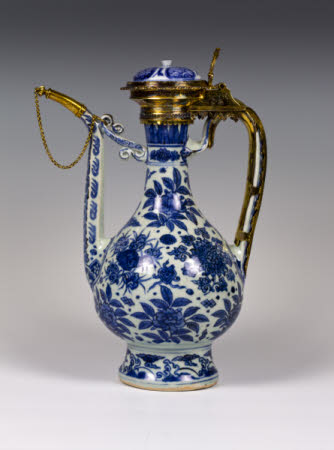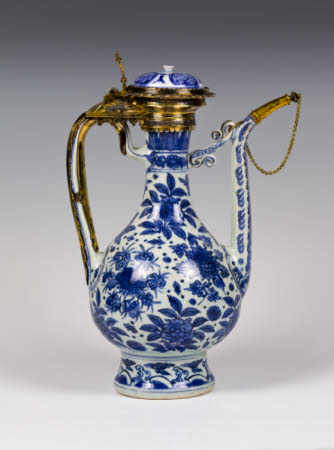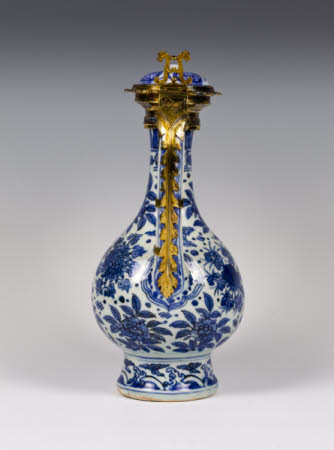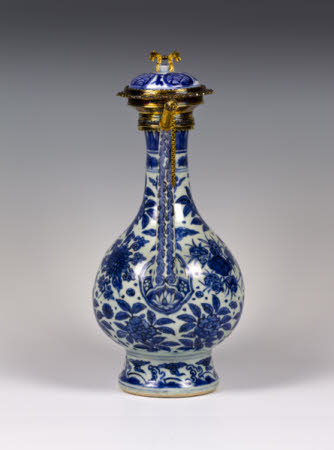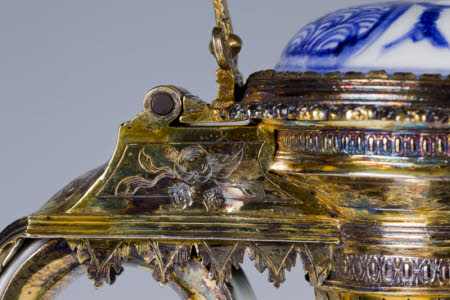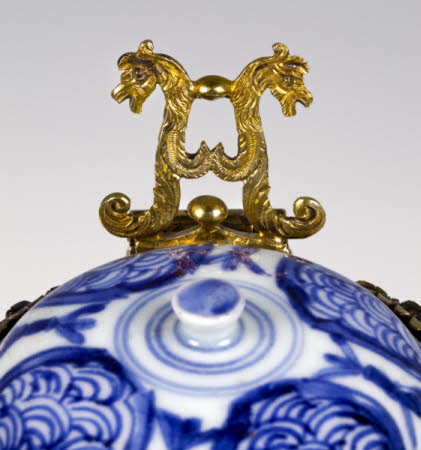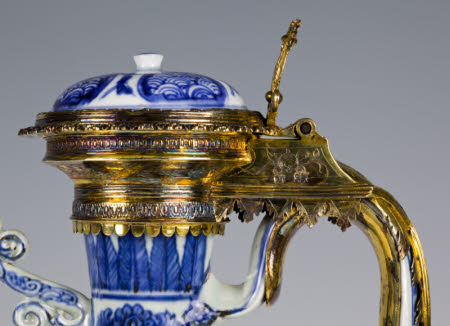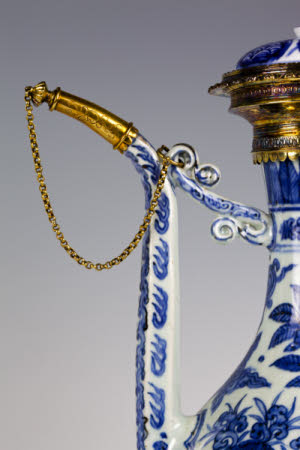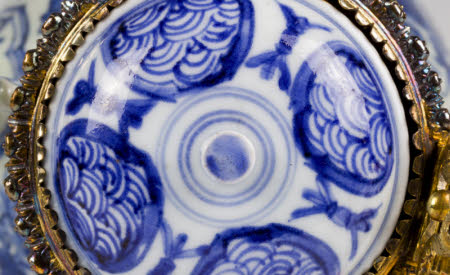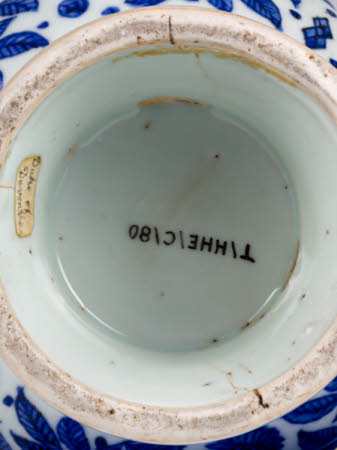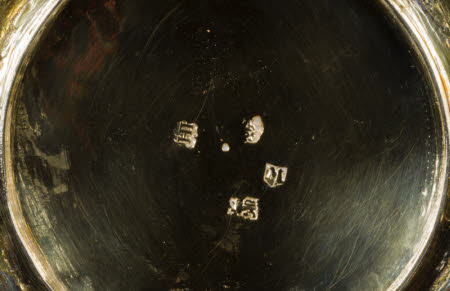Chinese porcelain ewer with English silver-gilt mounts
Category
Ceramics
Date
1550 - 1570 (the ewer; the mounts 1589/1590)
Materials
Porcelain, underglaze cobalt blue, gilded silver
Measurements
35.5 x 26 cm
Order this imageCollection
Hardwick Hall, Derbyshire
NT 1127144
Caption
By the 16th century, well before European craftspeople had learnt to manufacture hard white porcelain ware, Chinese porcelain was imported into Europe in significant quantities, often as part of a prized display of banqueting tableware. Jugs or ewers like this one were used in wealthy European households to hold scented rosewater for washing the hands between courses. This was a high-status ritual, and a useful one, as people often ate with their fingers. The shape of this ewer has been adopted from earlier gold vessels made in 15th-century China to hold wine for the imperial family during the Ming dynasty (1368–1644). The porcelain versions were decorated in blue and white, usually with naturalistic floral motifs as seen here. This example has been embellished with silver-gilt additions made in London, which were designed to make it easier to handle and to enhance its value. It is not known how this ewer came to Hardwick Hall in Derbyshire, since it does not seem to appear in the 1601 inventory of the possessions of Elizabeth Talbot, Countess of Shrewsbury (?1527–1608).
Summary
A blue and white porcelain ewer, made in the Jingdezhen (by unknown workshop) kilns in north-east Jiangxi province, south-east China, circa 1550–70, with English silver-gilt mounts marked for London (produced by unknown goldsmith), 1589–90, and with a silver-gilt thumbpiece added in 1850. With a domed lid and waisted body on a high, slightly flared skirting foot, the ewer painted in blue with flower shrubs, stylised flowers and a band of pal, at the neck. The spout vertical. The mount to the spout with plug and chain. The mark's to the mounts as follows: 1. ‘IH’ in a shaped shield, unidentified maker’s mark; 2. leopard’s head crowned, for London; 3. lion passant sterling standard; 4, date letter ‘M’. The maker's mark is unknown, but the same stamp appears on at least three other mounted porcelains. This ewer would have been used in China to pour wine, but was adapted by the addition of silver-gilt mounts, probably for use as a water receptacle for the ceremonial washing of hands before and during banquets, or as a wine decanter. The addition of the mounts had a practical purpose, but were also applied to highlight the rarity of this piece of exotic, high-status piece of porcelain. The 1601 inventory lists, among the 'Plate in the saide newe building', ten silver 'guilt' ewers and basins, and a 'pursland [porcelain] Cup with a Cover trimmed with silver and guilt'. The Hardwick ewer was recorded in a photograph of 1903, and was lent by the 9th Duke to the Burlington Fine Arts Club in 1910.
Full description
Among the earliest furnishings at Hardwick Hall, Derbyshire, built in 1590–7 for the formidable 'Bess of Hardwick', Elizabeth Talbot, Countess of Shrewsbury (1527–1608), is this porcelain ewer, made in about 1550–70 in Jingdezhen, a major centre for porcelain production in Jiangxi province, south China. Its shape is based on a Chinese metalware prototype and its blue-painted decoration includes scattered sprays of camellia and lotus, with auspicious emblems such as lingzhi (sacred mushrooms) among clouds above a band of breaking waves at the foot.1 Mass-produced in China, such ewers were distributed widely in the sixteenth century. There is an identical but unmounted example in the Topkapi Saray, Istanbul, and another, decorated with a design based on European fountains, is at Standen, West Sussex (NT 1213575).2 These vessels were used in China for wine, but in Europe they were filled with rose-scented water and presented by servants for hand washing at the start of a meal eaten with fingers, the spillage caught in a large porcelain dish that also served as its tray. The silver-gilt mounts, added by a London goldsmith in 1589–90, were designed to convert the ewer for this purpose, as well as serving as a display of wealth. To protect the contents, the spout has a fluted stopper attached by a fine chain. An openwork frame with a flame-like, serrated edge strengthens the handle and the cover is encased in a practical box-hinged mount. A thin protective coating of gold was washed over the silver, which is decorated with die-struck bands of ovolo ornament and finely etched panels of fruit. The mounts are marked inside the cover and on either side of the hinge-box with an ‘IH” within a shield. The unidentified goldsmith who used this mark commissioned specialists to make mounts for both porcelain and exotic natural objects, such as coconuts. His mark also appears on a decagonal frame of 1595–96 for a basin and on the mounts of 1599–1600 on the ‘Trenchard Bowl’, both in the Victoria and Albert Museum, as well as on a third, undated, example at Burghley House, Lincolnshire.3 Although its mounts date from a year before Bess embarked on building Hardwick, the ewer is not listed in a detailed inventory of 1501 – the only comparable items were ‘a pursland (porcelain) Cup with a Cover trimmed with silver and guilt waying fourteen ounces’ and eight German stoneware jugs with silver-gilt mounts.4 Nor does it appear in any inventories made when Bess’s descendant William Cavendish, 6th Duke of Devonshire (1790–1858), was spending much on preserving Hardwick’s Elizabethan furnishings.5 The jug probably arrived at Hardwick later in the nineteenth century, perhaps after it had been ‘improved’ by the addition of a cast Tudor-style flange thumb-piece of confronting griffins. By then the original porcelain cover, which had probably been broken, had been replaced by one made in about 1640.6 The earliest record of the ewer’s presence at Hardwick is a Country Life photograph taken in 1903, when Lady Louisa Egerton, née Cavendish (1835–1907), was living at Hardwck. This shows the ewer as part of a table arrangement of mounted Chinese porcelains in the Minstrels Gallery.7 It was lent by Victor Cavendish, 9th Duke of Devonshire (1868–1938), to an exhibition of Chinese ceramics in London in 1910.8 By about 1950, it was a prized heirloom displayed in the High Great Chamber, where it can be seen in a portrait of that date of the 9th Duke’s widow, Duchess Evelyn (1870–1960). Notes 1 British Museum inv. no. 1989,0213.1. 2 Krahl, Nurdan and Ayers 1986, vol. 2, cat. no. 1007. The ewer at Standen may have been ordered by Portuguese Jesuits for liturgical use. 3 Victoria and Albert Museum inv. no. 163-1879 and M.945-1983; Glanville 1990, cat. nos. 73-4. 4 Levey and Thornton 2001, pp. 37 and 58; Boynton 1971, pp. 1-14, at p. 35. 5 With thanks to James Towe and the Trustees of the Chatsworth Settlement, Derbyshire, for permission to consult the Devonshire archives. 6 Jackson-Stops (ed.) 1985, cat. no. 28. 7 Anon. 1903, p. 718; see NT 1127129-1127133 and NT 1127135. 8 Read (ed.) 1910, cat. no. E.21. Text adapted from Patricia F. Ferguson, Ceramics: 400 Years of British Collecting in 100 Masterpieces, London, Philip Wilson Publishers, 2016, pp. 12-13.
Provenance
By descent until, following the death of Edward William Spencer Cavendish, 10th Duke of Devonshire (1895 - 1950), Hardwick Hall and its contents were accepted by HM Treasury in part payment of death duties and transferred to the National Trust, in 1959.
Credit line
The Devonshire Collection, Hardwick Hall, Derbyshire, National Trust Collections
Marks and inscriptions
Lid lining and hinge: Silver stamped in the inner liner of the lid and hinge-box ('IH' in a shaped shield, unidentified maker's mark; leopard's head crownded, for London; lion passant, sterling standard; date letter 'M', for 1589–90).
References
Anon. 1903: Anon., ‘Hardwick Hall, Derbyshire, Seat of the Duke of Devonshire, Country Life, vol. 13, no. 334 (30 May 1903), pp. 710–18, at p. 718. Boynton 1971: Lindsay Boynton, 'The Hardwick Hall Inventories of 1601', Furniture History, vol. 7 (1971), pp. 1-14, at p. 35. Ferguson 2016: Patricia F. Ferguson, Ceramics: 400 Years of British Collecting in 100 Masterpieces, Philip Wilson Publishers, 2016, pp.12-3. Glanville 1990: Philippa Glanville, Silver in Tudor and Early Stuart England: A Social History and Catalogue of the National Collection 1480–1660, London, V&A Publications, 1990., cat. nos. 73-4. Jackson-Stops 1985: Gervase Jackson-Stops (ed.), The Treasure Houses of Britain: five hundred years of private patronage and art collecting, exh. cat. The National Gallery of Art, Washington, New Haven and London 1985, cat. no. 28, p. 105. Krahl, Nurdan and Ayers 1986: Regina Krahl, Erbahar Nurdan and John Ayers, Chinese Ceramics in the Topkapi Saray Museum, Istanbul: A Complete Catalogue (three vols.), London, Sotheby’s, 1986., vo. 2, cat. no. 1007. Levey and Thornton 2001: Santina Levey and Peter Thornton, Of Houshold Stuff: The 1601 Inventories of Bess of Hardwick, London, The National Trust, 2001, pp. 37 and 58. Read 1910: Sir Charles Hercules Read (ed.), Exhibition of Early Chinese Porcelain and Pottery, London, Burlington Fine Arts Club, 1910., cat. no. E.21. Rowell, Christopher, 'A Blue and White Chinese Porcelain Ewer', in Hardwick Hall: A Great Old Castle of Romance, eds., David Adshead and David Taylor (2016), fig. 338, p. 349.
